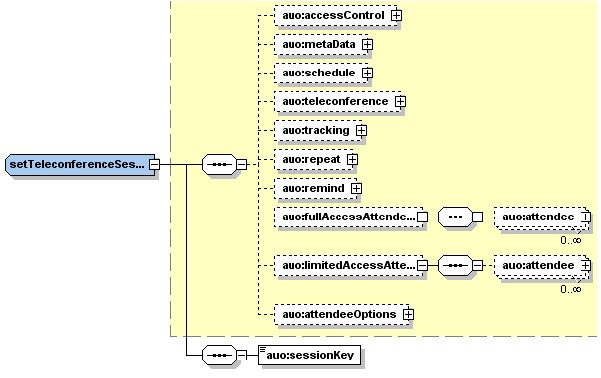SetTeleconferenceSession
Allows updating the information about a scheduled teleconference-only
meeting. If the Primary Large Telephony Server is unavailable, the page
first tries to connect to the NextGen telephony server. If that
connection is unavailable, the page will connect to the Backup 2 Large
server instead.
Note The API checks the password according to strict password
criteria settings in Site Admin for audio only meetings.
Request
The sample XML document shows an example of a request to update a teleconference-only meeting where the sessionKey is 11320765.
<?xml version="1.0" encoding="UTF-8"?>
<serv:message xmlns:xsi="http://www.w3.org/2001/XMLSchema-instance"
xmlns:serv="http://www.webex.com/schemas/2002/06/service">
<header>
<securityContext>
<webExID>hostid</webExID>
<password>hostpassword</password>
<siteID>0000</siteID>
<partnerID>9999</partnerID>
<email>johnsmith@xyz.com</email>
</securityContext>
</header>
<body>
<bodyContent xsi:type=
"java:com.webex.service.binding.meeting.auo.SetTeleconferenceSession"
xmlns:att="http://www.webex.com/schemas/2002/06/service/meeting">
<accessControl>
<listing>PUBLIC</listing>
<sessionPassword>123456</sessionPassword>
</accessControl>
<metaData>
<confName>Test Setting Teleconf-only</confName>
</metaData>
<schedule>
<startDate>04/18/2005 15:15:17</startDate>
<timeZoneID>16</timeZoneID>
<entryExitTone>BEEP</entryExitTone>
</schedule>
<teleconference>
<extTelephonyDescription>xmlSet</extTelephonyDescription>
</teleconference>
<repeat>
<repeatType>WEEKLY</repeatType>
<dayInWeek>
<day>TUESDAY</day>
<day>SATURDAY</day>
</dayInWeek>
</repeat>
<sessionKey>11320765</sessionKey>
</bodyContent>
</body>
</serv:message>
The following schema diagram shows the structure of the elements in thesetTeleconferenceSession request message.
Figure 5-20 • Schema diagram for setTeleconferenceSession
For descriptions of the global elements in the security context of the
header, see Global Request Elements in Security Context. For
descriptions of the non-global elements, refer to “Elements in WebEx XML
Schema Definitions for the Meeting Service”.
Response
The sample XML document shows an example of a possible response to the
preceding request document.
<?xml version="1.0" encoding="UTF-8"?>
<serv:message xmlns:serv="http://www.webex.com/schemas/2002/06/service"
xmlns:com="http://www.webex.com/schemas/2002/06/common"
xmlns:auo="http://www.webex.com/schemas/2002/06/service/meeting/auo">
<serv:header>
<serv:response>
<serv:result>SUCCESS</serv:result>
<serv:gsbStatus>PRIMARY</serv:gsbStatus>
</serv:response>
</serv:header>
<serv:body>
<serv:bodyContent xsi:type="auo:setTeleconferenceSessionResponse"
xmlns:xsi="http://www.w3.org/2001/XMLSchema-instance" />
</serv:body>
</serv:message>
The following schema diagram shows the structure of the elements in thesetTeleconferenceSessionResponse message.
Figure 5-21 • Schema diagram for setTeleconferenceSessionResponse
The result and exceptionID global elements allow you to confirm that an instantiation request was successful. These elements are described in “Global Response Elements Showing Results and Errors”.

